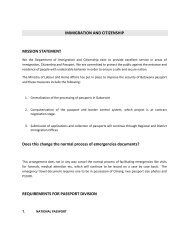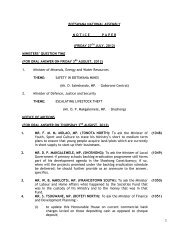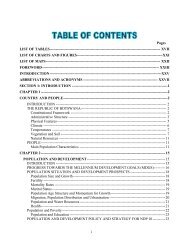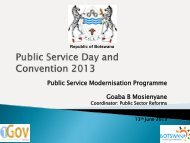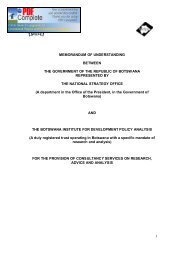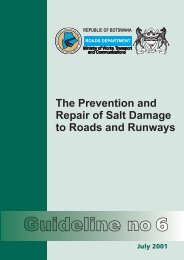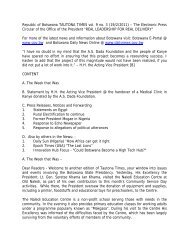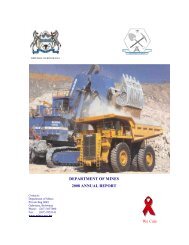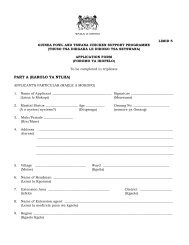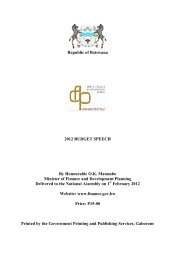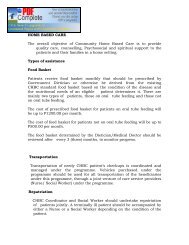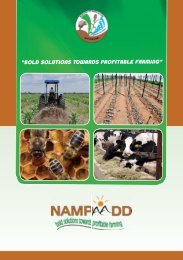Tourism Statistics - Government of Botswana
Tourism Statistics - Government of Botswana
Tourism Statistics - Government of Botswana
Create successful ePaper yourself
Turn your PDF publications into a flip-book with our unique Google optimized e-Paper software.
3.2 <strong>Tourism</strong> Characteristic Industries<br />
The TSA: RMF sets out clearly the <strong>Tourism</strong> Characteristic Industries for which it is appropriate to<br />
present information on their production (See Annex 5). Such information is reliant upon two<br />
aspects:<br />
(1) The National Accounts relating to the different production industries; and<br />
(2) The details on tourist‟s expenditure in the appropriate product categories as shown in Annex 5,<br />
which itself is reliant upon the sample surveys undertaken.<br />
With these constraints it has been found necessary to limit the TSA to the main tourism industries,<br />
which were:<br />
<strong>Tourism</strong> collective accommodation (but not second homes);<br />
Restaurants and similar;<br />
Road Transport;<br />
Air Transport;<br />
Travel Agencies/ Tour Operators (margins); and<br />
Other industries.<br />
Lack <strong>of</strong> information on Second Homes used for tourism purposes in <strong>Botswana</strong> means that it is not<br />
possible to compile suitable statistics. Rail travel for tourism purposes is thought to be minimal.<br />
Water Travel is similarly minimal. For the other categories <strong>of</strong> either expenditure or industries,<br />
identifying these separately has not been possible, so they are put together in the category<br />
„others‟. In principle Goods should be treated separately from services: for goods (shopping) only<br />
the retail trade margin generates tourism value added, not the total value <strong>of</strong> the good purchased.<br />
3.3 Production Accounts<br />
The production accounts for the above six industries have been estimated by using the information<br />
available from the CSO, for the national accounts for 2005/2006. The CSO National Accounts give<br />
the key breakdowns into Intermediate Consumption and into Gross Value Added. Both Output and<br />
Gross Value Added are in Basic Prices. The difference between Basic Prices, Producer Prices and<br />
Purchasers‟ Prices is illustrated in Annex 6.<br />
The TSA: RMF recommends a specific format for Table 5 <strong>of</strong> the TSA, which sets out the<br />
production <strong>of</strong> products by the <strong>Tourism</strong> Characteristic Industries and then outlines the Inputs which<br />
will make up Intermediate Consumption, and then finally gives a breakdown <strong>of</strong> Gross Value Added<br />
into its components. (For the relationship between these macroeconomic aggregates, see Annex<br />
7)<br />
A key issue here is that a particular product can be produced by more than one industry, and <strong>of</strong><br />
course a tourism industry can produce products other than the product that is its typical output.<br />
Identifying and then measuring these different components is a critical task. Here in <strong>Botswana</strong> it<br />
has not been possible to identify these boundaries with clarity, and for this reason the gross<br />
figures <strong>of</strong> output for any industry may cover other products as well.<br />
Additionally, the output <strong>of</strong> any industry, even a tourism industry, is seldom consumed 100% by<br />
tourists. Except for the accommodation services for visitors, the bulk <strong>of</strong> the products go to nontourism<br />
use.<br />
In order to keep broad comparability with the National Accounts process, „Cost <strong>of</strong> Sales‟ has been<br />
included with Intermediate Consumption. The Production Accounts are in Table 5.<br />
26



